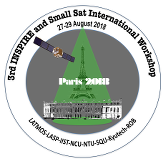Speaker
Dr
Athanassios Katsiyannis
(Royal Observatory of Belgium)
Description
We present the analysis of energetic particles, indirectly detected by the Large Yield RAdiometer (LYRA) instrument on board ESA's Project for On-board Autonomy 2 (PROBA2) satellite in the form of microbursts of <10 ms, with a phenomenon duration of 100 s. Combining Energetic Particle Telescope (EPT/PROBA-V) observations with LYRA data for an overlapping period of time, we identified these particles as electrons with an energy range of 2 to 8 MeV. The observed events are strongly correlated to geo-magnetic activity and appear even during modest disturbances. Additionally, they are well confined geographically within the L=4-6 McIlwain zones, and they show prominent dawn-dusk and day-night asymmetries.
Summary
Those detections clearly illustrate that although LYRA is built as an EUV irradiometer, it can also reliably detect in-situ relativistic electrons. The scientific value of this discovery and its implication to solar irradiometer designs will also be discussed.
Primary author
Dr
Athanassios Katsiyannis
(Royal Observatory of Belgium)
Co-author
Marie Dominique
(ROB)

